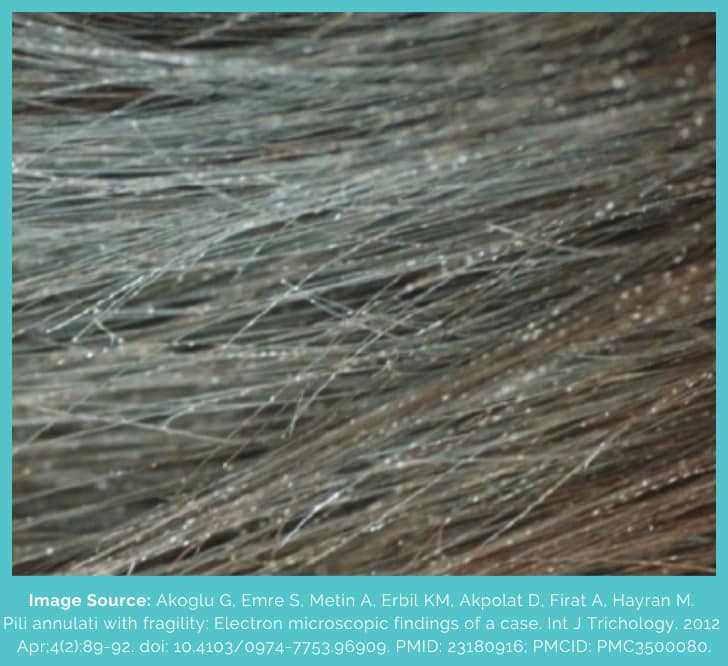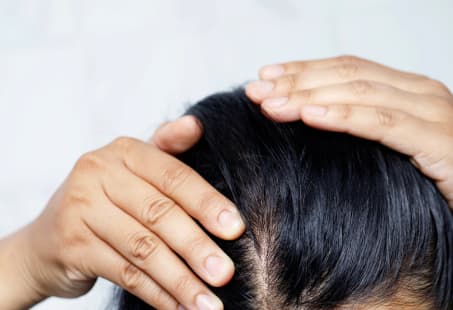It is everyone’s desire to have shiny, glossy hair. While some struggle to make their hair so, those with pili annulati are born with a hair shaft defect that gives their hair a shiny (yet striped) appearance.
Essentially, it’s a defect in the internal structure of the hair, and because of the way it scatters light, you can see dark and light bands on the hair.
Fortunately, this condition is benign (not harmful). So, there’s not much to worry about unless it’s affecting the hair strength and making it fall out more. In that case, there are some things you can do to take care of your hair.
In this guide, you’ll learn more about that and find out what exactly makes the hair shine so peculiarly in pili annulati.
What Is Pili Annulati?
Pili annulati – also known as ringed hair or morse-code like hair – is a rare defect of the hair shaft because of the presence of abnormal air-filled cavities in its cortex (middle layer of the hair).

Unlike many other hair shaft disorders that leave the hair fragile (like trichorrhexis nodosa and invaginata, monilethrix, or pili torti), usually, it’s not a characteristic feature of pili annulati.
Still, according to a review published in Skin Appendage Disorders, there have been reports of people with pili annulati who experienced more fragility and breakage. They even had “indentations, cracking, and folding” of their hair shafts.
Pili annulati itself is a permanent condition that will last for your entire life, appearing after birth or in early childhood. In light-coloured hair, it is more noticeable; it can also become more prominent with age (especially in dark-haired people) as the hair becomes grey.
It can be seen in different areas of the scalp, could be anywhere between 20% and 80%. But it can affect other hair-bearing areas on the body as well, such as the beard and armpits.
How Common Is Pili Annulati?
According to StatPearls, there’s no data on the prevalence rate of pili annulati. Still, in general, this condition is considered rare.
As mentioned in the introduction, this condition was first described by Landois in 1866, and since then, only 50 cases have been reported. However, it’s possible that this condition is underreported.
Not everyone is aware of the fact that they have pili annulati. For example, those with dark hair might not even see it until their hair starts greying.
What Causes Pili Annulati?
Pili annulati is an inherited condition which is autosomal dominant. So, the child receives a mutated copy of a gene from only one parent and ends up developing this condition.
The reason why you see light and dark coloured bands is that there are abnormal air pockets in the hair shaft.
It’s not exactly known how this condition develops, but there are different theories which involve defects in proteins or formation of the hair matrix.
What Are The Symptoms Of Pili Annulati?
While shiny stripes on hair strands is what mainly defines pili annulati, it may be accompanied by some other signs. According to Online Mendelian Inheritance in Man (OMIM), this condition can:
- Make the hair look lustreless
- Give the hair a speckled appearance
- May make the hair lengths uneven because of breakage near air pockets

The overall thickness of the shaft remains the same, and there are no changes in the hair growth either (so it won’t cause alopecia).
Also, it should be noted that while pili annulati usually occurs in isolation, it’s been associated with some other illnesses like melanoderma, leukonychia and alopecia areata.
An interesting thing about the last one is that a case report published in Clinical and Experimental Dermatology described a 6-year-old patient whose pili annulati disappeared after she had an episode of alopecia totalis (complete loss of hair on scalp).
Even more peculiarly, the opposite of this has also been reported with a patient developing pili annulati after an episode of alopecia areata.
What Is The Treatment For Pili Annulati?
Pili annulati doesn’t require treatment since it’s not a harmful condition. However, if it’s causing increased breakage due to fragility, your doctor might recommend you to adopt gentler hair care practices.
It can include avoiding:
- Aggressive hair combing
- Tying the hair too tightly
- Heat styling tools
- Exposing hair to strong chemicals (like bleaches and dyes)
- Accessories (wigs or pins) that pull at the hair
In any case, you should further talk to your doctor about it.
Conclusion
Pili annulati is one of those rare hair disorders that are not actually bothersome. In fact, you may even enjoy the shine imparted to your hair by this condition.
Keep in mind that it will stay with you for a lifetime, and if you have dark hair, you might start seeing these bands once you start growing the whites.
Because it’s benign, it doesn’t require any treatment. Still, if you’re bothered by its presence (if it’s drawing too much attention), you should consider talking to a board-certified medical professional.
They’ll first provide you with an accurate diagnosis and then prepare a treatment plan accordingly.
Reviewed and Approved by Trichologist Yaprak Yazan


